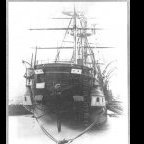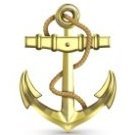MORE HANDBOOKS ARE ON THEIR WAY! We will let you know when they get here.
×
-
Posts
1,868 -
Joined
-
Last visited
Reputation Activity
-
 Chuck Seiler reacted to Louie da fly in Winchelsea Nef 1274 A.D. by Louie da fly - FINISHED - 1:75
Chuck Seiler reacted to Louie da fly in Winchelsea Nef 1274 A.D. by Louie da fly - FINISHED - 1:75
And more frames, and the second through-beam is in place. Note the new frames don't have the lower crossbeams.
And I occasionally get to cut the floor timbers with the grain following the line of the frames.
And here we get to see the amount of room there is in the hold of you omit those lower crossbeams.
Cutting the holes for the through-beams for the forecastle.
And making beam clamps for the deck beams.
Beam clamps bent to follow the ship's hull.
And glued in place.
Forecastle through-beam in place -
and deck beam below it.
Next job is to add the beam clamps for the forecastle and rest of the deck-beams at this end. And then repeat everything at the other end.
Steven
-
 Chuck Seiler got a reaction from Matt D in Winchelsea Nef 1274 A.D. by Louie da fly - FINISHED - 1:75
Chuck Seiler got a reaction from Matt D in Winchelsea Nef 1274 A.D. by Louie da fly - FINISHED - 1:75
Steven,
I am pulling up a chair. I am considering that model as well. It was going to be after my cog, but I stalled on the cog and another project interceded.
I have the book as well. I do not read or speak German but the plans are pretty good and there are some fine diagrams. It covers the nef and another that resembles a longboat, but was used by William the Conqueror...after all, Normans WERE Viking descendants. The plans yielded the following model which can be found on the internet. I can send the link. There are multiple angles and interior shots
I had not chosen NOT to name my log (when I make one) Winchelsea Nef because everybody will be opening it expecting a frigate. 😄However, if you look at the transom of Chuck P's WINCHELSEA model, you will find the nef.
-
 Chuck Seiler got a reaction from flying_dutchman2 in Winchelsea Nef 1274 A.D. by Louie da fly - FINISHED - 1:75
Chuck Seiler got a reaction from flying_dutchman2 in Winchelsea Nef 1274 A.D. by Louie da fly - FINISHED - 1:75
Steven,
I agree with this conclusion. That is what I was trying to indicate in post 136, but it was very wordy and may have missed the point. Long story short: The frames that contained the thru beams were centrally located and provided stability. The cargo area could be accessed via removable deck planks and ran thru-beam frame to thru-beam frame. (In other words the area between thru deck frames formed sort of a compartment).
Here is the best picture I could find to illustrate the removable planks. They include fingerholes and don't appear too water tight.
Deck winch. Most of the ones I have seen, and the way depicted in Zimmerman, was that the hole/slot went all of the way through the windlass so the windlass bar could be used to stop/hold the windlass in place.
-
 Chuck Seiler got a reaction from Louie da fly in Winchelsea Nef 1274 A.D. by Louie da fly - FINISHED - 1:75
Chuck Seiler got a reaction from Louie da fly in Winchelsea Nef 1274 A.D. by Louie da fly - FINISHED - 1:75
We'll build the ships. Let them worry about how they will load their cargo, eh?
-
 Chuck Seiler got a reaction from mtaylor in Winchelsea Nef 1274 A.D. by Louie da fly - FINISHED - 1:75
Chuck Seiler got a reaction from mtaylor in Winchelsea Nef 1274 A.D. by Louie da fly - FINISHED - 1:75
We'll build the ships. Let them worry about how they will load their cargo, eh?
-
 Chuck Seiler got a reaction from mtaylor in Winchelsea Nef 1274 A.D. by Louie da fly - FINISHED - 1:75
Chuck Seiler got a reaction from mtaylor in Winchelsea Nef 1274 A.D. by Louie da fly - FINISHED - 1:75
My concern would be for the cargo, but I supposed most/all would be packed in barrels.
-
 Chuck Seiler got a reaction from Keith Black in Winchelsea Nef 1274 A.D. by Louie da fly - FINISHED - 1:75
Chuck Seiler got a reaction from Keith Black in Winchelsea Nef 1274 A.D. by Louie da fly - FINISHED - 1:75
We'll build the ships. Let them worry about how they will load their cargo, eh?
-
 Chuck Seiler got a reaction from GrandpaPhil in Winchelsea Nef 1274 A.D. by Louie da fly - FINISHED - 1:75
Chuck Seiler got a reaction from GrandpaPhil in Winchelsea Nef 1274 A.D. by Louie da fly - FINISHED - 1:75
Steven,
I agree with this conclusion. That is what I was trying to indicate in post 136, but it was very wordy and may have missed the point. Long story short: The frames that contained the thru beams were centrally located and provided stability. The cargo area could be accessed via removable deck planks and ran thru-beam frame to thru-beam frame. (In other words the area between thru deck frames formed sort of a compartment).
Here is the best picture I could find to illustrate the removable planks. They include fingerholes and don't appear too water tight.
Deck winch. Most of the ones I have seen, and the way depicted in Zimmerman, was that the hole/slot went all of the way through the windlass so the windlass bar could be used to stop/hold the windlass in place.
-
 Chuck Seiler got a reaction from Keith Black in Winchelsea Nef 1274 A.D. by Louie da fly - FINISHED - 1:75
Chuck Seiler got a reaction from Keith Black in Winchelsea Nef 1274 A.D. by Louie da fly - FINISHED - 1:75
My concern would be for the cargo, but I supposed most/all would be packed in barrels.
-
 Chuck Seiler reacted to Louie da fly in Winchelsea Nef 1274 A.D. by Louie da fly - FINISHED - 1:75
Chuck Seiler reacted to Louie da fly in Winchelsea Nef 1274 A.D. by Louie da fly - FINISHED - 1:75
Thanks for the input, Chuck. I think we must have been writing at the same time as each other.
I don't suppose they have to be on what is in effect an open boat, especially as they can be removed to bale her out. I really don't know if pumps were in use at this time - though Woodrat put them on his near-contemporary Venetian Round Ship, I don't know of any evidence of them being used in the Atlantic. Time to have another look at the archaeological reports on cogs - nah, no mention of pumps at all.
Yes, this is confirmed by the windlass barrel from the Ijsselcog.
The Bremen cog has not only a windlass but a capstan as well, and though the best photo I've been able to find is a bit equivocal, it looks like the holes go all the way through on this one too. An easy way to stop it unwinding without ratchets and pawls.
Oh, and I've found some earlier representations of cogs - dating back to 1267 and 1280 - exactly contemporary with the Winchelsea nef.
Steven
-
 Chuck Seiler got a reaction from Cathead in Winchelsea Nef 1274 A.D. by Louie da fly - FINISHED - 1:75
Chuck Seiler got a reaction from Cathead in Winchelsea Nef 1274 A.D. by Louie da fly - FINISHED - 1:75
Steven,
I agree with this conclusion. That is what I was trying to indicate in post 136, but it was very wordy and may have missed the point. Long story short: The frames that contained the thru beams were centrally located and provided stability. The cargo area could be accessed via removable deck planks and ran thru-beam frame to thru-beam frame. (In other words the area between thru deck frames formed sort of a compartment).
Here is the best picture I could find to illustrate the removable planks. They include fingerholes and don't appear too water tight.
Deck winch. Most of the ones I have seen, and the way depicted in Zimmerman, was that the hole/slot went all of the way through the windlass so the windlass bar could be used to stop/hold the windlass in place.
-
 Chuck Seiler reacted to Louie da fly in Winchelsea Nef 1274 A.D. by Louie da fly - FINISHED - 1:75
Chuck Seiler reacted to Louie da fly in Winchelsea Nef 1274 A.D. by Louie da fly - FINISHED - 1:75
Just going through some more info. The evidence whether nefs had a raised deck (level with the top of the through-beams) is a bit contradictory. I've already shown the Winchelsea nef in my previous post, and the crew certainly seem to be standing on a raised deck. This is supported by the seal of Yarmouth St Nicholas
and an illustration from the Bestiary of 1225-1250, MS Bodley 764 supports this idea.
However, another illustration from the same source contradicts this,
as does an illustration fro BL Egerton MS 3028
Unfortunately, most of the other town seals could be interpreted either way - plenty of crew members shown, but their feet may or may not be standing on a raised deck. Here are the seals of Sandwich and San Sebastian.
It's quite possible that both types existed. In any case, I'm still going with the raised deck for my model, as it's pretty evident that the ship on the Winchelsea seal has one.
Steven
-
 Chuck Seiler got a reaction from mtaylor in Winchelsea Nef 1274 A.D. by Louie da fly - FINISHED - 1:75
Chuck Seiler got a reaction from mtaylor in Winchelsea Nef 1274 A.D. by Louie da fly - FINISHED - 1:75
Steven,
I agree with this conclusion. That is what I was trying to indicate in post 136, but it was very wordy and may have missed the point. Long story short: The frames that contained the thru beams were centrally located and provided stability. The cargo area could be accessed via removable deck planks and ran thru-beam frame to thru-beam frame. (In other words the area between thru deck frames formed sort of a compartment).
Here is the best picture I could find to illustrate the removable planks. They include fingerholes and don't appear too water tight.
Deck winch. Most of the ones I have seen, and the way depicted in Zimmerman, was that the hole/slot went all of the way through the windlass so the windlass bar could be used to stop/hold the windlass in place.
-
 Chuck Seiler got a reaction from Keith Black in Winchelsea Nef 1274 A.D. by Louie da fly - FINISHED - 1:75
Chuck Seiler got a reaction from Keith Black in Winchelsea Nef 1274 A.D. by Louie da fly - FINISHED - 1:75
Steven,
I agree with this conclusion. That is what I was trying to indicate in post 136, but it was very wordy and may have missed the point. Long story short: The frames that contained the thru beams were centrally located and provided stability. The cargo area could be accessed via removable deck planks and ran thru-beam frame to thru-beam frame. (In other words the area between thru deck frames formed sort of a compartment).
Here is the best picture I could find to illustrate the removable planks. They include fingerholes and don't appear too water tight.
Deck winch. Most of the ones I have seen, and the way depicted in Zimmerman, was that the hole/slot went all of the way through the windlass so the windlass bar could be used to stop/hold the windlass in place.
-
 Chuck Seiler reacted to Louie da fly in Winchelsea Nef 1274 A.D. by Louie da fly - FINISHED - 1:75
Chuck Seiler reacted to Louie da fly in Winchelsea Nef 1274 A.D. by Louie da fly - FINISHED - 1:75
I've added some extra frames; the next one in sequence will incorporate the second through-beam.
But I've come across a problem that is going to plague me unless I do something about it. With the crossbeams the way they are, the hold of the nef isn't going to have enough vertical room in it. The knarr I'm taking most of my structure from seems to have its hold open to the sky - there's no evidence of deck-beams above the hold - but the town seals of nefs show figures obviously standing on a raised deck.
And the combination of this deck and the crossbeams below restricts the height available for cargo to an unacceptable level. In the real world if a person was standing on the crossbeams, the deck would only be up to his waist.
I'm looking more and more at cogs for a model to work from with this. Yes, they're a later vessel, but as I've found from looking at town seals, not that much later. Though the Bremen cog dates to 1380, there are contemporary representations of them as early as c. 1310, only 36 years later than the Winchelsea seal.
The construction of a cog doesn't have these crossbeams down in the bilges - in fact they are quite lightly constructed. In fact, checking on the Ijsselcog find, (see https://www.academia.edu/40371597/The_IJsselcog_project_from_excavation_to_3D_reconstruction ) I've found my suspicions about the construction method confirmed. The frames are made up of three futtocks, connected simply by scarph joints - one of which is at the sharp corner at the turn of the bilge, though there is a knee there to reinforce it.
And I think this is why they have those hefty through-beams; they're needed to compensate from the lightweight construction. I note also that at least some of the through-beams are reinforced with hefty knees (see fig. 23 above, and the photo of the Bremen cog in an earlier post). In the Ijsselcog these knees are fixed through the planking to wales on the outer surface of the hull.
This form of construction allows for a very considerable amount of room for cargo, whilst being strong enough to cope with wind and wave.
I'm not going to change what I've already done - apart from anything else, the upper deck will hide the through-beams I've already put in. But I think I'm going to follow the cog construction as far as I can for any future frames. I also need to consider those great big knees used on the cog, and see if they are appropriate to the nef. As it appears to be flush-decked apart from the small fore and after decks, I may have to compromise with smaller knees, to allow access fore and aft.
Still a work in progress.
On another subject, and getting a bit ahead of myself, I'd been wondering about the function of the windlass and whether it was used to raise the sail, and if so, whether there was anything in between (such as a bollard) the halyard was tied to once the yard was raised. I found some video of sail being raised on the Viking reconstruction Harald Fairhair -
So yes, if this is any guide, the windlass is specifically to hoist the yard, and the halyard runs directly to the windlass and is held there by it, without any bollard or whatever.
Steven
-
 Chuck Seiler reacted to Cathead in Winchelsea Nef 1274 A.D. by Louie da fly - FINISHED - 1:75
Chuck Seiler reacted to Cathead in Winchelsea Nef 1274 A.D. by Louie da fly - FINISHED - 1:75
So much cool knowledge coming out of this!
-
 Chuck Seiler got a reaction from ChiefClanker in Winchelsea Nef 1274 A.D. by Louie da fly - FINISHED - 1:75
Chuck Seiler got a reaction from ChiefClanker in Winchelsea Nef 1274 A.D. by Louie da fly - FINISHED - 1:75
Or duct tape.
-
 Chuck Seiler got a reaction from Louie da fly in Winchelsea Nef 1274 A.D. by Louie da fly - FINISHED - 1:75
Chuck Seiler got a reaction from Louie da fly in Winchelsea Nef 1274 A.D. by Louie da fly - FINISHED - 1:75
Or duct tape.
-
 Chuck Seiler got a reaction from mtaylor in Winchelsea Nef 1274 A.D. by Louie da fly - FINISHED - 1:75
Chuck Seiler got a reaction from mtaylor in Winchelsea Nef 1274 A.D. by Louie da fly - FINISHED - 1:75
Or duct tape.
-
 Chuck Seiler reacted to Louie da fly in Winchelsea Nef 1274 A.D. by Louie da fly - FINISHED - 1:75
Chuck Seiler reacted to Louie da fly in Winchelsea Nef 1274 A.D. by Louie da fly - FINISHED - 1:75
I've just changed the way I do the frames - instead of assembling the frame and then putting it in place, I've just started making the frame in its constituent pieces, making sure everything fits properly dry fitted, then gluing it in piece by piece.
I find this allows the frame pieces to fit more tightly inside the planking. Hardly any extra work, and a better result. And it's probably the way they did it back in the day (but with nails/treenails instead of glue, of course).
Steven
-
 Chuck Seiler got a reaction from mtaylor in Winchelsea Nef 1274 A.D. by Louie da fly - FINISHED - 1:75
Chuck Seiler got a reaction from mtaylor in Winchelsea Nef 1274 A.D. by Louie da fly - FINISHED - 1:75
Kingship and Maritime Power in 10th‐Century England, by Matthew Firth and Erin Sebo—has been published in the International Journal of Nautical Archeology. You have to be a member of an institution to access the article and I fear the "San Diego Mental Hospital" doesn't qualify. An article I read that summarizes it states that English naval tradition goes back to before Alfred...there was a battle with the Vikings in 851. Alfred had a couple battles but the article suggests his ships weree not all that great. Comparison of 'burial ships' over the years suggests "Similarities in burial configuration and in ship design across these regions demonstrate ongoing cultural contact, resulting in comparable technological innovations in warship design between England and Scandinavia, and common cultural attitudes to the importance and prestige of sea-power."
If you build below average ships and your neighbor, a seafaring group of hardies, builds better ships, you copy those. So, while England may have had its own shipbuilding traditions, I contend they were influenced by the Scandinavians LONG before 1066. I agree, ship design was not the same in 1250 as it was in 950 and a nef is not a knarr, but I suspect there is much carry over.
-
 Chuck Seiler got a reaction from Roger Pellett in Winchelsea Nef 1274 A.D. by Louie da fly - FINISHED - 1:75
Chuck Seiler got a reaction from Roger Pellett in Winchelsea Nef 1274 A.D. by Louie da fly - FINISHED - 1:75
Normans were Vikings and 13th century English aristocracy were Normans.
-
 Chuck Seiler reacted to Louie da fly in Winchelsea Nef 1274 A.D. by Louie da fly - FINISHED - 1:75
Chuck Seiler reacted to Louie da fly in Winchelsea Nef 1274 A.D. by Louie da fly - FINISHED - 1:75
I've cut the holes in the planking for the central through-beam.
First frame finished and in place. It's the central one with the through-beam, and the mast will be immediately aft of it.
And second frame in place.
The first one I made won't be put it in immediately - I'm using it as a sort of template to keep the spacing etc correct for the following ones.
Now that I've got into my rhythm, they are coming together fairly smoothly and without too much time taken for each one.
Steven
-
 Chuck Seiler got a reaction from Keith Black in Winchelsea Nef 1274 A.D. by Louie da fly - FINISHED - 1:75
Chuck Seiler got a reaction from Keith Black in Winchelsea Nef 1274 A.D. by Louie da fly - FINISHED - 1:75
Kingship and Maritime Power in 10th‐Century England, by Matthew Firth and Erin Sebo—has been published in the International Journal of Nautical Archeology. You have to be a member of an institution to access the article and I fear the "San Diego Mental Hospital" doesn't qualify. An article I read that summarizes it states that English naval tradition goes back to before Alfred...there was a battle with the Vikings in 851. Alfred had a couple battles but the article suggests his ships weree not all that great. Comparison of 'burial ships' over the years suggests "Similarities in burial configuration and in ship design across these regions demonstrate ongoing cultural contact, resulting in comparable technological innovations in warship design between England and Scandinavia, and common cultural attitudes to the importance and prestige of sea-power."
If you build below average ships and your neighbor, a seafaring group of hardies, builds better ships, you copy those. So, while England may have had its own shipbuilding traditions, I contend they were influenced by the Scandinavians LONG before 1066. I agree, ship design was not the same in 1250 as it was in 950 and a nef is not a knarr, but I suspect there is much carry over.
-
 Chuck Seiler got a reaction from Keith Black in Winchelsea Nef 1274 A.D. by Louie da fly - FINISHED - 1:75
Chuck Seiler got a reaction from Keith Black in Winchelsea Nef 1274 A.D. by Louie da fly - FINISHED - 1:75
Normans were Vikings and 13th century English aristocracy were Normans.


.thumb.jpg.6d6ee4bdbfaac2c58ecc77e7b80ae374.jpg)





